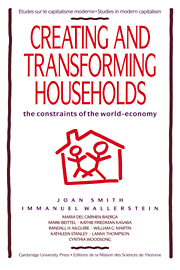Book contents
- Frontmatter
- Contents
- Preface
- I INTRODUCTION
- II THE UNITED STATES
- III MEXICO
- Introduction
- 1 Mexico City: the slow rise of wage-centered households
- 2 Central Mexico: the decline of subsistence and the rise of poverty
- IV SOUTHERN AFRICA
- V CONCLUSION
- A postscript on method
- References
- Index
- Studies in Modern Capitalism
Introduction
Published online by Cambridge University Press: 07 June 2010
- Frontmatter
- Contents
- Preface
- I INTRODUCTION
- II THE UNITED STATES
- III MEXICO
- Introduction
- 1 Mexico City: the slow rise of wage-centered households
- 2 Central Mexico: the decline of subsistence and the rise of poverty
- IV SOUTHERN AFRICA
- V CONCLUSION
- A postscript on method
- References
- Index
- Studies in Modern Capitalism
Summary
Throughout the nineteenth century, Mexico was a peripheral region of the world-system. The Mexican economy suffered from a dependence upon the production of silver for export, the scarcity of credit, the lack of technical innovation, and the absence of anything resembling an integrated national market. In the cities, the guild system deteriorated, but the factory system was still in its most incipient stage. Agriculture was dominated by large “feudal” estates juxtaposed to subsistence-oriented peasants, although in many areas small-scale independent producers rivaled the larger estates (Cardoso, 1983). It is not at all clear that Mexico shared the midcentury (1848–73) expansion of the world-economy and the first three-quarters of the nineteenth century are generally considered to be one long period of economic stagnation in Mexico (López Càmara, 1984; Padilla, 1968; Rodríguez, 1983).
The latter half of the “great depression” of 1873–96 in the core are as witnessed important institutional changes in Mexico, especially during the 1880s, followed by strong economic growth from roughly 1890 to 1910. The downswing of the 1880s in the United States, France, and Great Britain led to the investment of foreign capital in Mexico, especially in the railroads. In turn, the development of extensive railways, actively promoted by the government, served as a major economic catalyst and was associated with an eventual expansion of exports as well as the nascent integration of the domestic market.
- Type
- Chapter
- Information
- Creating and Transforming HouseholdsThe Constraints of the World-Economy, pp. 145 - 149Publisher: Cambridge University PressPrint publication year: 1992

